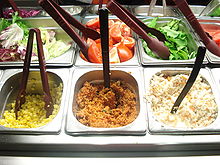SAE 304 stainless steel

SAE 304 stainless steel is the most common stainless steel. The steel contains both chromium (between 18% and 20%) and nickel (between 8% and 10.5%)[1] metals as the main non-iron constituents. It is an austenitic stainless steel. It is less electrically and thermally conductive than carbon steel. It is magnetic, but less magnetic than steel. It has a higher corrosion resistance than regular steel and is widely used because of the ease in which it is formed into various shapes.[1]
The composition was developed by W. H. Hatfield at Firth-Vickers in 1924 and was marketed under the trade name "Staybrite 18/8".[2]
It is specified by SAE International as part of its SAE steel grades. Outside the US it is commonly known as A2 stainless steel, in accordance with ISO 3506 for fasteners.[3] In the commercial cookware industry it is known as 18/8 stainless steel. In the unified numbering system it is UNS S30400. The Japanese equivalent grade of this material is SUS304. It is also specified in European norm 1.4301.
Chemical Composition[]
| Type 304 Stainless Steel Chemical Composition,[4] % | ||||||||
| Standard | AISI (UNS) | C, ≤ | Si, ≤ | Mn, ≤ | P, ≤ | S, ≤ | Cr | Ni |
| ASTM A276/A276M | 304 (S30400) | 0.08 | 1.00 | 2.00 | 0.045 | 0.030 | 18.0-20.0 | 8.0-11.0 |
Corrosion resistance[]
304 stainless steel has excellent resistance to a wide range of atmospheric environments and many corrosive media. It is subject to pitting and crevice corrosion in warm chloride environments and to stress corrosion cracking above about 60 °C. It is considered resistant to pitting corrosion in water with up to about 400 mg/L chlorides at ambient temperatures, reducing to about 150 mg/L at 60 °C.
304 stainless steel is also very sensitive at room temperature to the thiosulfate anions released by the oxidation of pyrite (as encountered in acid mine drainage) and can undergo severe pitting corrosion problems when in close contact with pyrite- or sulfide-rich clay materials exposed to oxidation.[citation needed]
For more severe corrosion conditions, when 304 stainless steel is too sensitive to pitting or crevice corrosion by chlorides or general corrosion in acidic applications, it is commonly replaced by 316 stainless steel.[citation needed]
Applications[]

304 stainless steel is used for a variety of household and industrial applications such as food handling and processing equipment, screws,[5] machinery parts, utensils, and car headers. 304 stainless steel is also used in the architectural field for exterior accents such as water and fire features. It is also a common coil material for vaporizers.
Early SpaceX Starships used SAE 301 Stainless Steel in their construction,[6] before moving over to SAE 304L for the SN7 test tank[7] and Starship SN8 in 2020.[8]
Carbon content[]
304, 304H and 304L all possess the same nominal chromium and nickel content[clarification needed] and thus possess the same corrosion resistance, ease of fabrication and weldability.
The carbon content of 304H (UNS S30409) is restricted to 0.04–0.10%, which provides optimal high temperature strength.[citation needed]
The carbon content of 304L (UNS 30403) is restricted to a maximum of 0.03%, which prevents sensitization during welding. Sensitization is the formation of chromium carbides along grain boundaries when a stainless steel is exposed to temperatures in the approximate range range of 900–1,500 °F (480–820 °C). The subsequent formation of chromium carbide results in reduced corrosion resistance along the grain boundary leaving the stainless steel susceptible to unanticipated corrosion in an environment where 304 would be expected to be corrosion resistant. This grain boundary corrosive attack is known as intergranular corrosion.[citation needed]
The carbon content of 304 (UNS 30400) is restricted to a maximum of 0.08%. Thus 304 is not useful for corrosive applications where welding is required such as tanks and pipes where corrosive solutions are involved, thus, 304L is preferred. And its lack of a minimum carbon content is not ideal for high temperature applications where optimal strength is required, thus, 304H is preferred. Thus 304 is typically restricted to bars that will be machined into components where welding is not required or thin sheets that are formed in articles such as kitchen sinks or cookware that are also not welded.[citation needed]
Carbon content has a strong influence on room temperature strength and thus the specified minimum tensile properties of 304L are 5 kilopounds per square inch (34 MPa) lower than for 304. However, nitrogen also has a strong influence on room temperature strength and a tiny addition of nitrogen produces 304L with the same tensile strength as 304. Thus, practically all 304L is produced as dual certified 304/304L, meaning it meets the minimum carbon content of 304L and also meets the minimum tensile strength of 304.[9][full citation needed]
See also[]
References[]
- ^ Data sheet on SAE 304 stainless steel.
- ^ https://www.flightglobal.com/pdfarchive/view/1937/1937%20-%201048.html
- ^ "Stainless Steel Fasteners". Australian Stainless Steel Development Association. Archived from the original on 2007-09-29. Retrieved 2007-08-13.
- ^ AISI SAE 304 Stainless Steel Properties.
- ^ "Stainless Steel Fasteners". Australian Stainless Steel Development Association. Archived from the original on 2007-09-29. Retrieved 2007-08-13.
- ^ Mike Wall (2020). "SpaceX's Starship will soon be made of different stuff". space.com. Retrieved 30 May 2021.
- ^ Matthew Greenwood (22 August 2020). "SpaceX's Starship Vehicle Aces First Test Flight". engineering.com. Retrieved 30 May 2021.
- ^ Areeb Ali (28 October 2020). "The Test Flight of SpaceX's Starship Prototype SN 8 Is Excitement Guaranteed". The Wire. Retrieved 30 May 2021.
- ^ "Easily distinguishing tips between 304,304H and 304L".
- Stainless steel